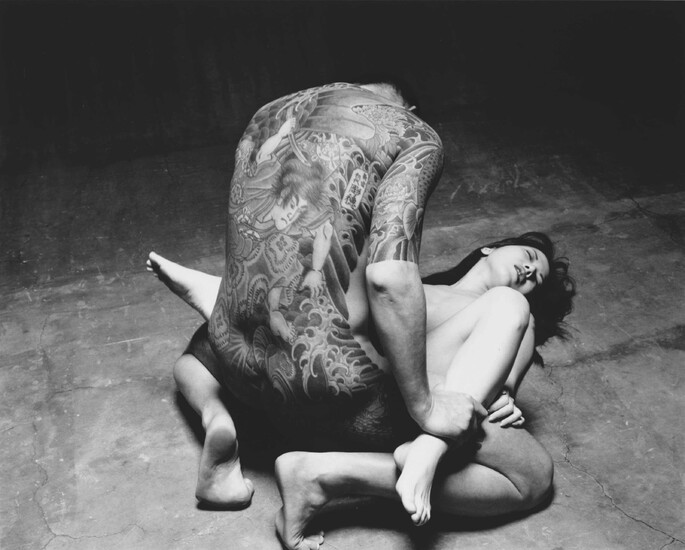Araki Nobuyoshi - Yakuza Copulating
From the series: TOKYO COMEDY 1998
Gelatin silver print
46 x 57.6 cm (50.7 x 60.5 cm)
Matted and framed
Signed in pencil on the verso
Provenance
From the photographer studio, printed in early 2000
Literature
Nobuyoshi Araki, Araki by Araki. The Photographer’s Personal Selection, 1963-2002, Tokyo i.a. 2003, ill. p. 356; Akiko Miki (ed.), Nobuyoshi Araki, Self. Life. Death, London 2011, ill. p. 650; Nobuyoshi Araki, Araky by Araki, Cologne i.a. 2014.
The stage-like produced shot of a couple during intercourse occupies a particular position in Araki's work. Not only the absence of any accessories which place the scenery in a spatial or narrative context, as is usual for Araki, but also the presence of a male actor which presets something extraordinary in Araki's pictorial cosmos. It is striking that this man, who, like a demon, leans over the body of a woman sunk to the floor in ecstasy, is distinguishable by an impressive full body tattoo.
This form of body ornament was reserved in Japan for decades for members of the Yakuza, that notorious criminal organisation with a mafia-like clan structure, and is still today considered offensive in public life. That man's tattoos form the centre of the shot, a "picture within a picture" as it were. It shows the well-known motif of the legendary warrior monk Benkei as young Oniwakamaru, fighting the giant carp after a woodcut by Utagawa Kuniyoshi (1798-1861) at the end of the Edo period.
This motif has a long tradition in the Japanese tattoo art irezumi. Full body tattoos of this scene were already found in the 19th century. In addition, the tattoo here is of particularly good quality, executed by the famous tattoo artist Horitoku, one of the leading masters of the traditional art of Japanese tattoos and who immortalised himself with his signature on the man's back.
Location
Auction House
From the series: TOKYO COMEDY 1998
Gelatin silver print
46 x 57.6 cm (50.7 x 60.5 cm)
Matted and framed
Signed in pencil on the verso
Provenance
From the photographer studio, printed in early 2000
Literature
Nobuyoshi Araki, Araki by Araki. The Photographer’s Personal Selection, 1963-2002, Tokyo i.a. 2003, ill. p. 356; Akiko Miki (ed.), Nobuyoshi Araki, Self. Life. Death, London 2011, ill. p. 650; Nobuyoshi Araki, Araky by Araki, Cologne i.a. 2014.
The stage-like produced shot of a couple during intercourse occupies a particular position in Araki's work. Not only the absence of any accessories which place the scenery in a spatial or narrative context, as is usual for Araki, but also the presence of a male actor which presets something extraordinary in Araki's pictorial cosmos. It is striking that this man, who, like a demon, leans over the body of a woman sunk to the floor in ecstasy, is distinguishable by an impressive full body tattoo.
This form of body ornament was reserved in Japan for decades for members of the Yakuza, that notorious criminal organisation with a mafia-like clan structure, and is still today considered offensive in public life. That man's tattoos form the centre of the shot, a "picture within a picture" as it were. It shows the well-known motif of the legendary warrior monk Benkei as young Oniwakamaru, fighting the giant carp after a woodcut by Utagawa Kuniyoshi (1798-1861) at the end of the Edo period.
This motif has a long tradition in the Japanese tattoo art irezumi. Full body tattoos of this scene were already found in the 19th century. In addition, the tattoo here is of particularly good quality, executed by the famous tattoo artist Horitoku, one of the leading masters of the traditional art of Japanese tattoos and who immortalised himself with his signature on the man's back.



